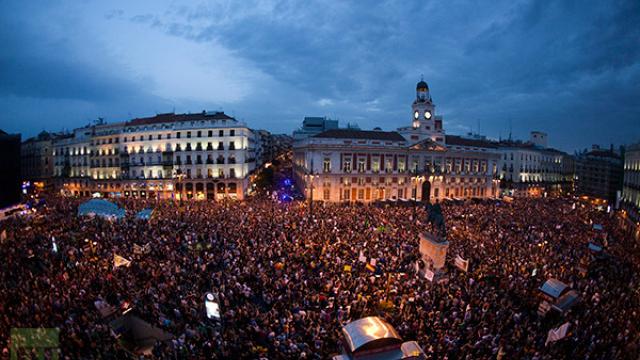
Photo: Paul Hanna. Spanish protesters fill up the Puerta del Sol square during a protest marking the one year anniversary of Spain's Indignados movement.
Last June, after leaving the encampment in the center of Madrid, people in the 15M Movement would say, “We moved from Sol square, but we know the way back.”
The day of action on May 12 exceeded the expectations of many people who thought the 15M movement was dead, who didn’t recognize that it had moved to neighborhood assemblies. The one-year anniversary of the movement brought hundreds of thousands of people to the streets again in nearly 80 Spanish cities. There were 50,000 in Madrid, 44,000 in Barcelona, 11,000 in Vigo (a northern city with a population of less than 300,000) and many more.
As people from around the country converged on Madrid, various neighborhood assemblies gathered in squares to prepare banners for the demonstration and to share tips for avoiding police repression. At 7 p.m., there were five columns of demonstrators marching toward Sol square, where they planned to arrive at 9 p.m. But by 8 p.m., the first column had already arrived, filling almost half of the square. Other groups of marchers arrived within minutes, but many people could not enter and had to stay in nearby streets. Sol square was completely full before the meeting time. There, thousands sang “Happy Birthday” to the 15M movement and released balloons.
As Sol square transformed into a party celebrating a year of protest and organizing, the question remained of whether the party could last all night. Some weeks before, the government had announced that it would not allow an encampment in Sol at all, but last Thursday it granted the movement a right to stay in the square during “office hours.” When the government’s 10 p.m. curfew came, there were more than 15,000 people in the square, surrounded by about 2,000 police officers.
The first tent was erected. “Now we have more reason than last year,” said a man named Emilio, the first camper in Sol that night. “I’m not afraid to be the first one. If the police arrest me, they will have to go through many more people.” A half hour later, above where a dozen police vans were parked, a huge white panel was deployed, on which were projected videos created by the movement.
After midnight, preparations began to hold an assembly. Dozens cleaned the paper and bottles littered across the square, while others placed cardboard on the ground for people to sit on. When the assembly started at 1 a.m., nearly 2,000 participated. “I was worried,” one of the first people to take the microphone said. “This was very much a party, and we have a lot of work to do.” The first question was whether to stay in Sol for the night, and debate continued for more than an hour and a half. Many wanted to remain, but others said that doing so would only be a provocation to the government and didn’t make sense.
The assembly ended at 4 a.m., but hundreds of people remained in Sol. An hour later, 30 more police vans arrived, and officers cleared the square. Eighteen people were arrested. Meanwhile, police swept the squares in Valencia, Palma de Mallorca and other cities where activists tried to spend the night. Catalunya square in Barcelona is the only place where the movement has been able to remain, thanks to authorization by the Catalan government.
May 12 was just the first day of mobilization, and the most festive. Leading up to May 15, the movement has planned actions across the country focused on housing rights, employment, economy and democracy. These are busy days for the movement, and they will certainly be instrumental in shaping its goals and the strategies used to achieve them. Luckily, we know the way back.
3 WAYS TO SHOW YOUR SUPPORT
- Log in to post comments











